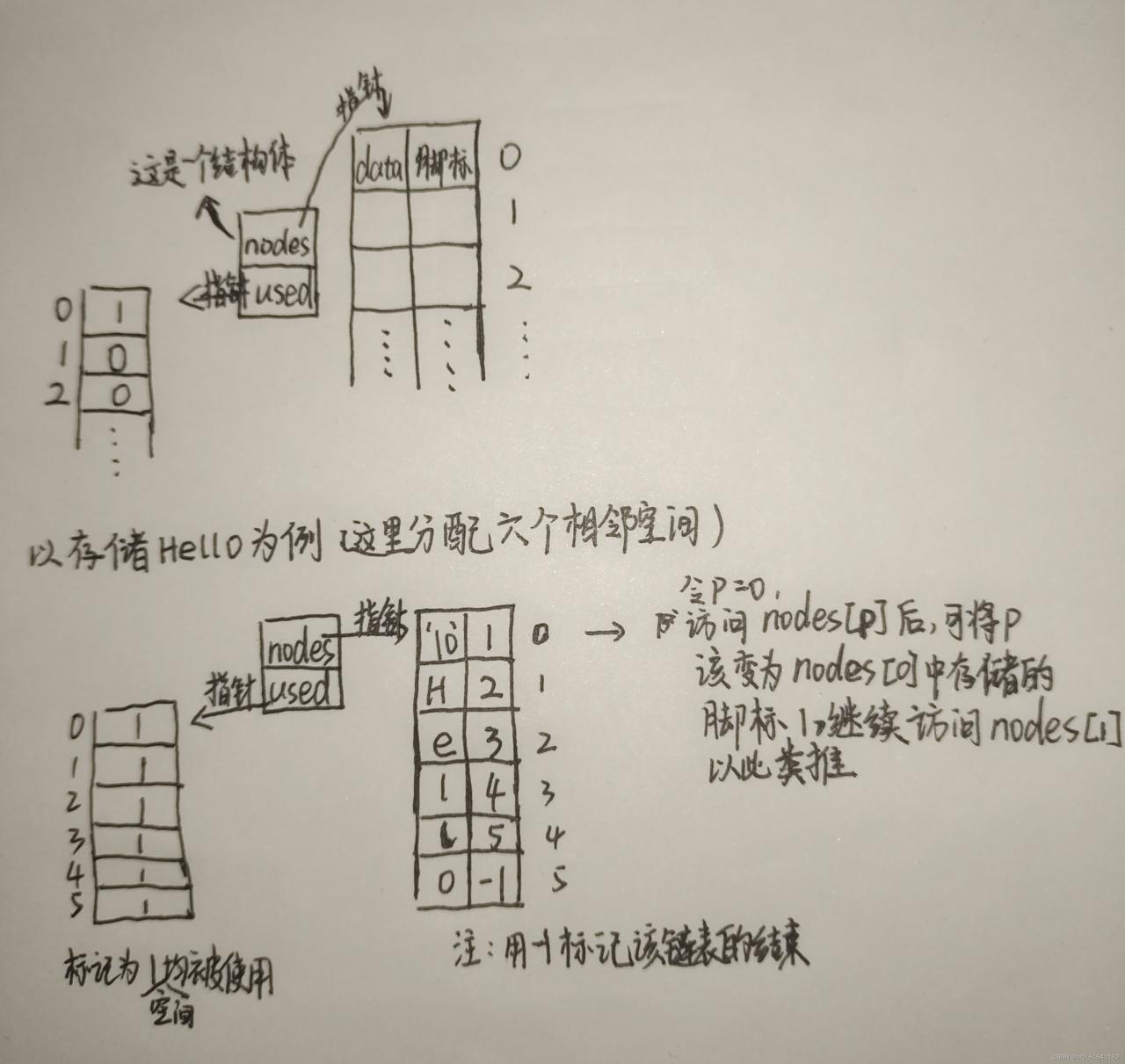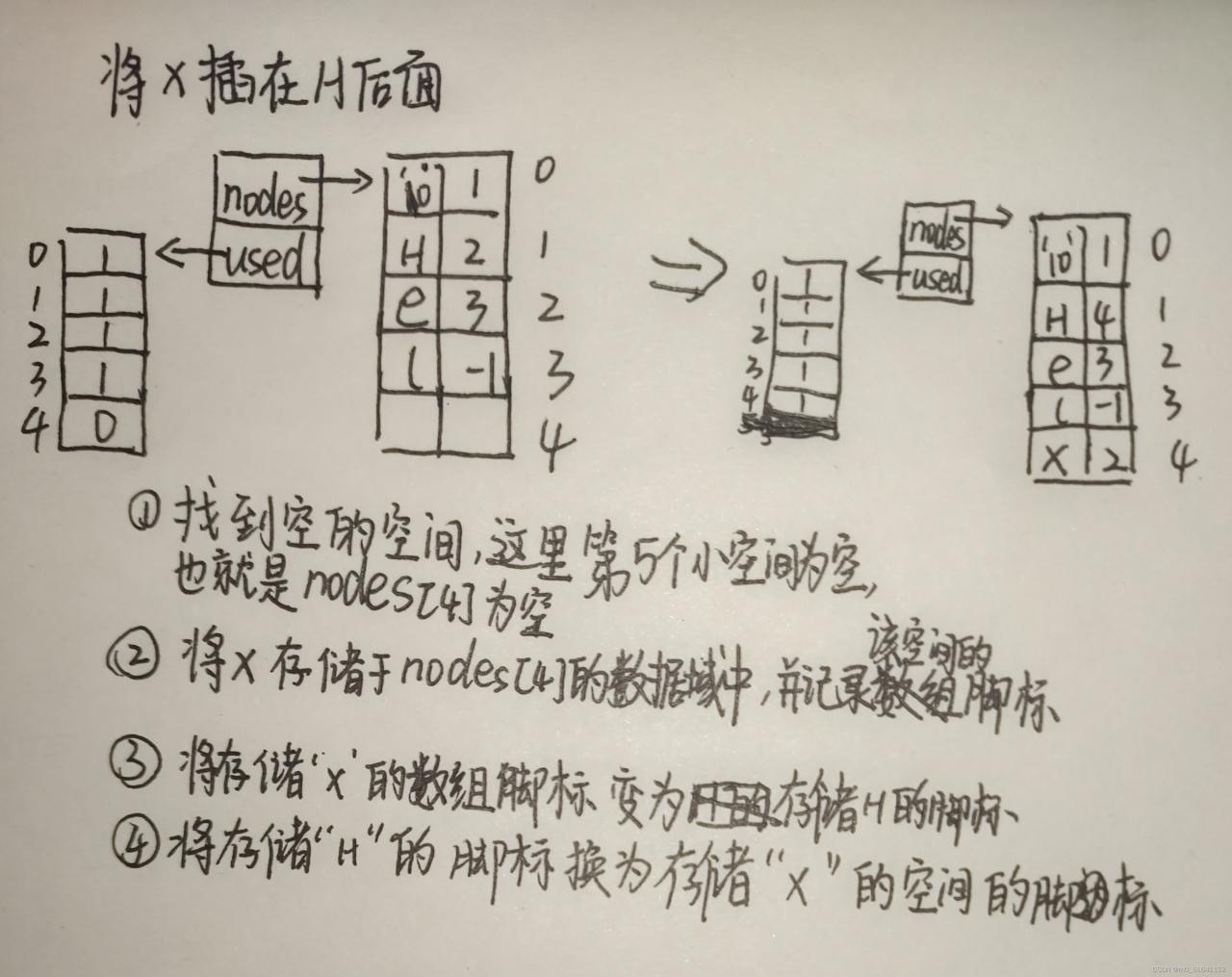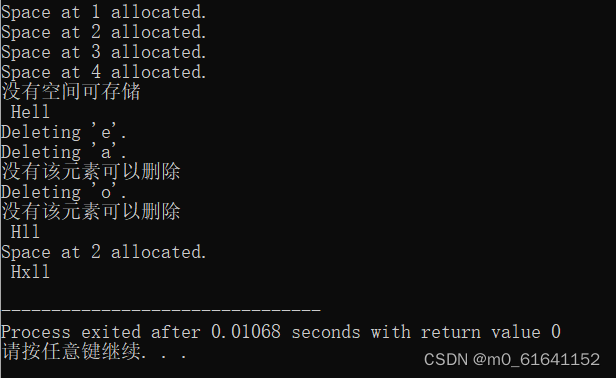静态链表不同于单链表的有:静态链表所分配的存储数据的空间是相邻的,这个空间就像是数组空间,不同的是每个小空间内不止存有有数据,而且还有数字,这里的数字就作为访问数组内下一个小空间的脚标,起到了类似指针的作用;静态链表不仅包括了数组的空间,还分配了一个数组大小和存储数据的数组大小相同的空间,用于0和1标记存储数据的空间是否已经被使用。同时静态链表的空间在使用过程中大小不变。而单链表每个空间不一定相邻,采用的是指针连接,且空间可变
具体理解请结合图示,代码一起理解:
图示:

存储数据的结构体
typedef struct StaticLinkedNode{
char data;//数据
int next;//脚标
}*NodePtr;指向两片空间的指针的结构体
typedef struct StaticlinkedList{
NodePtr nodes;//指向存储空间区域
int *used;//指向判断 储空间区域是否被使用的区域
}*ListPtr; 静态链表的初始化
ListPtr initLinkedList(){
ListPtr tempPtr = (ListPtr)malloc(sizeof(struct StaticlinkedList));
tempPtr->nodes = (NodePtr)malloc(sizeof(struct StaticLinkedNode)*DEFAULT_SIZE);//用于储存数据 ,得到空间
tempPtr->used = (int*)malloc(sizeof(int)*DEFAULT_SIZE);//用于标记空间是否被占用
tempPtr->nodes[0].data = '\0';
tempPtr->nodes[0].next = -1;
tempPtr->used[0] = 1;
for(int i = 1;i < DEFAULT_SIZE;i++){
tempPtr->used[i] = 0;
}
return tempPtr;
}//静态链表的初始化 打印链表
void printList(ListPtr paraListPtr){
int p = 0;
while(p!=-1){
printf("%c",paraListPtr->nodes[p].data);
p = paraListPtr->nodes[p].next;
}
printf("\r\n");
}//打印链表 静态链表的插入

上图中还差一步将空间标记为已使用状态
代码的实现
void insertElement(ListPtr paraListPtr, char paraChar, int paraPosition){
int p = 0,q,i;
for(i = 0;i < paraPosition;i++){
if(paraListPtr->nodes[p].next == -1){
printf("超出链表此时的长度,不存在第%d位置\r\n",paraPosition);
return;
}
p = paraListPtr->nodes[p].next;
}//判断该位置是否存在
for(i = 0;i < DEFAULT_SIZE;i++){
if(paraListPtr->used[i] == 0){
printf("Space at %d allocated.\r\n", i);
q = i;
paraListPtr->nodes[q].data = paraChar;
paraListPtr->used[i] = 1;
break;
}
}//追踪数据储存的空间的区域
if(i == DEFAULT_SIZE){
printf("没有空间可存储\r\n");
return;
}//判断该静态链表还是否存在多余的空间
paraListPtr->nodes[q].next = paraListPtr->nodes[p].next;
paraListPtr->nodes[p].next = q;
}
链表中元素的删除
同理可得
void deleteElement(ListPtr paraListPtr, char paraChar){
int p,q;
p = 0;
while((paraListPtr->nodes[p].next !=-1 )&&(paraListPtr->nodes[paraListPtr->nodes[p].next].data != paraChar)){
p = paraListPtr->nodes[p].next;
}//移动至要删除的元素的前一片空间
if( paraListPtr->nodes[p].next== -1){
printf("没有该元素可以删除\r\n");
return;
}
q = paraListPtr->nodes[p].next;
paraListPtr->nodes[p].next = paraListPtr->nodes[paraListPtr->nodes[p].next].next;//删除元素
paraListPtr->used[q] = 0;//释放空间,将空间标记为未使用状态
} //删除元素函数 完整代码
#include <stdio.h>
#include <malloc.h>
#define DEFAULT_SIZE 5
typedef struct StaticLinkedNode{
char data;
int next;
}*NodePtr;
typedef struct StaticlinkedList{
NodePtr nodes;
int *used;
}*ListPtr;
ListPtr initLinkedList(){
ListPtr tempPtr = (ListPtr)malloc(sizeof(struct StaticlinkedList));
tempPtr->nodes = (NodePtr)malloc(sizeof(struct StaticLinkedNode)*DEFAULT_SIZE);//用于储存数据 ,得到空间
tempPtr->used = (int*)malloc(sizeof(int)*DEFAULT_SIZE);//用于标记空间是否被占用
tempPtr->nodes[0].data = '\0';
tempPtr->nodes[0].next = -1;
tempPtr->used[0] = 1;
for(int i = 1;i < DEFAULT_SIZE;i++){
tempPtr->used[i] = 0;
}
return tempPtr;
}//静态链表的初始化
void printList(ListPtr paraListPtr){
int p = 0;
while(p!=-1){
printf("%c",paraListPtr->nodes[p].data);
p = paraListPtr->nodes[p].next;
}
printf("\r\n");
}//打印链表
void insertElement(ListPtr paraListPtr, char paraChar, int paraPosition){
int p = 0,q,i;
for(i = 0;i < paraPosition;i++){
if(paraListPtr->nodes[p].next == -1){
printf("超出链表此时的长度,不存在第%d位置\r\n",paraPosition);
return;
}
p = paraListPtr->nodes[p].next;
}//判断该位置是否存在
for(i = 0;i < DEFAULT_SIZE;i++){
if(paraListPtr->used[i] == 0){
printf("Space at %d allocated.\r\n", i);
q = i;
paraListPtr->nodes[q].data = paraChar;
paraListPtr->used[i] = 1;
break;
}
}//追踪数据储存的空间的区域
if(i == DEFAULT_SIZE){
printf("没有空间可存储\r\n");
return;
}//判断该静态链表还是否存在多余的空间
paraListPtr->nodes[q].next = paraListPtr->nodes[p].next;
paraListPtr->nodes[p].next = q;
}
void deleteElement(ListPtr paraListPtr, char paraChar){
int p,q;
p = 0;
while((paraListPtr->nodes[p].next !=-1 )&&(paraListPtr->nodes[paraListPtr->nodes[p].next].data != paraChar)){
p = paraListPtr->nodes[p].next;
}//移动至要删除的元素的前一片空间
if( paraListPtr->nodes[p].next== -1){
printf("没有该元素可以删除\r\n");
return;
}
q = paraListPtr->nodes[p].next;
paraListPtr->nodes[p].next = paraListPtr->nodes[paraListPtr->nodes[p].next].next;//删除元素
paraListPtr->used[q] = 0;//释放空间
} //删除元素函数
void appendInsertDeleteTest(){
ListPtr tempList = initLinkedList();
printList(tempList);
insertElement(tempList, 'H', 0);
insertElement(tempList, 'e', 1);
insertElement(tempList, 'l', 2);
insertElement(tempList, 'l', 3);
insertElement(tempList, 'o', 4);
printList(tempList);//测试插入函数
printf("Deleting 'e'.\r\n");
deleteElement(tempList, 'e');
printf("Deleting 'a'.\r\n");
deleteElement(tempList, 'a');
printf("Deleting 'o'.\r\n");
deleteElement(tempList, 'o');
printList(tempList);//测试删除函数
insertElement(tempList, 'x', 1);
printList(tempList);
}//测试函数
int main(){
appendInsertDeleteTest();
}测试结果

版权声明:本文为m0_61641152原创文章,遵循 CC 4.0 BY-SA 版权协议,转载请附上原文出处链接和本声明。